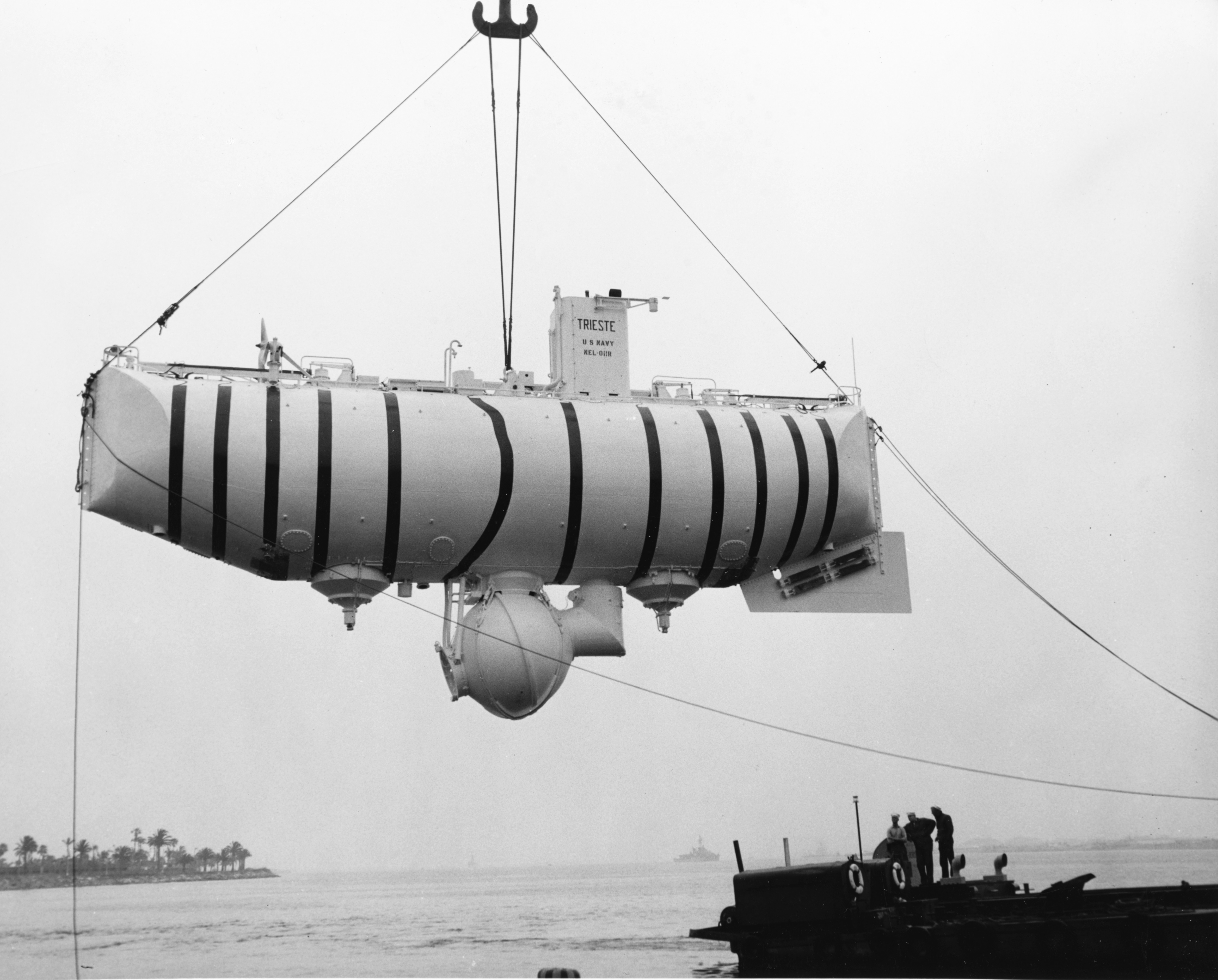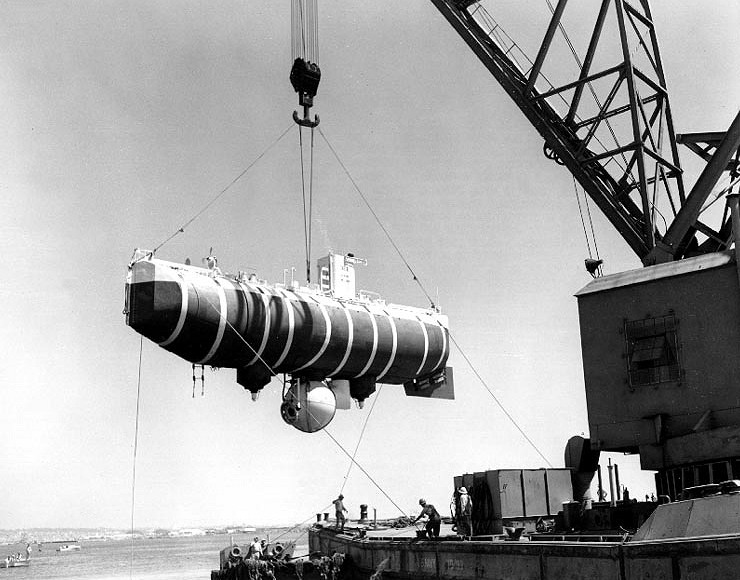|
Archimède
The bathyscaphe ''Archimède'' is a deep diving research submersible of the French Navy. It used of hexane as the gasoline buoyancy of its float. It was designed by Pierre Willm and Georges Houot. In 1964, ''Archimède'' descended into "what was then thought to be the deepest part of the Puerto Rico Trench", which the NY Times reported as . On 21 December 2018, a dive by Victor Vescovo in the DSV Limiting Factor found the "true bottom" of the Atlantic Ocean to be , in the first manned descent to the deepest "verified bottom" of the Atlantic Ocean. ''Archimède'' was christened on 27 July 1961, at the French Navy base of Toulon. It was designed to go beyond , and displaced 61 tons. In October 1961, ''Archimède'' passed its first dive tests, diving to unmanned. On 27 November 1961, ''Archimède'' achieved a speed of , over a distance of at a depth of in the Mediterranean Sea. On 23 May 1962, ''Archimède'' descended to off Honshu, Japan, in the Pacific, at the Japan D ... [...More Info...] [...Related Items...] OR: [Wikipedia] [Google] [Baidu] |
Georges Houot
Georges Houot (29 August 1913 – 7 August 1977) was a French naval officer and commander of a bathyscaphe unit. Biography He was born in Paris and educated at the Prytanée militaire military school at La Flèche in the Pays de la Loire region. In 1933 he entered the Naval College near Brest in Brittany where he trained to be a torpedo officer. As an officer he served on the cruiser ''Gloire'' from 1940 to 1941, the destroyer ''Hardi'' in 1942 and the frigates ''Croix-de-Lorraine'' (1945–47) and ''Lac Pavin'' (1947–49). In 1949, Houot succeeded Jacques Cousteau as commander of the underwater research vessel, ''Élie Monnier'', which was used for exploring the sea bed. In spite of suffering from the after-effects of polio he took part in the diving activities of the men under his command and developed an interest in underwater research. In 1951 he was chosen to direct the trials of the ''FNRS III'' bathyscaphe, and in 1953 was given overall command of the bathyscaphes. O ... [...More Info...] [...Related Items...] OR: [Wikipedia] [Google] [Baidu] |
Bathyscaphe
A bathyscaphe ( or ) is a free-diving self-propelled deep-sea submersible, consisting of a crew cabin similar to a bathysphere, but suspended below a float rather than from a surface cable, as in the classic bathysphere design. The float is filled with gasoline because it is readily available, buoyant, and, for all practical purposes, incompressible. The incompressibility of the gasoline means the tanks can be very lightly constructed, since the pressure inside and outside the tanks equalises, eliminating any differential. By contrast, the crew cabin must withstand a huge pressure differential and is massively built. Buoyancy at the surface can be trimmed easily by replacing gasoline with water, which is denser. Auguste Piccard, inventor of the first bathyscaphe, composed the name ''bathyscaphe'' using the Ancient Greek words βαθύς ''bathys'' ("deep") and σκάφος ''skaphos'' ("vessel"/"ship"). Mode of operation To descend, a bathyscaphe floods air tanks with se ... [...More Info...] [...Related Items...] OR: [Wikipedia] [Google] [Baidu] |
Puerto Rico Trench
The Puerto Rico Trench is located on the boundary between the Caribbean Sea and the Atlantic Ocean. The oceanic trench, the deepest in the Atlantic, is associated with a complex transition between the Lesser Antilles subduction zone to the south and the major transform fault zone or plate boundary, which extends west between Cuba and Hispaniola through the Cayman Trough to the coast of Central America. The trench is long and has a maximum depth of or 5.20 miles. This constitutes the single deepest point in the Atlantic Ocean. This point is commonly referred to as the Milwaukee Deep, with the Brownson Deep naming the seabed surrounding it. However, more recently, the latter term has also been used interchangeably with the former to refer to this point. The exact point was identified by the '' DSSV Pressure Drop'' using a state-of-the-art Kongsberg EM124 multibeam sonar in 2018, and then directly visited and its depth verified by the crewed submersible Deep-Submergence Vehicle ... [...More Info...] [...Related Items...] OR: [Wikipedia] [Google] [Baidu] |
DSV Limiting Factor
A deep-submergence vehicle (DSV) is a deep-diving crewed submersible that is self-propelled. Several navies operate vehicles that can be accurately described as DSVs. DSVs are commonly divided into two types: research DSVs, which are used for exploration and surveying, and DSRVs (Deep Submergence Rescue Vehicle), which can be used for rescuing the crew of a sunken navy submarine, clandestine (espionage) missions (primarily installing wiretaps on undersea communications cables), or both. DSRVs are equipped with docking chambers to allow personnel ingress and egress via a manhole. The real-life feasibility of any DSRV-based rescue attempt is hotly debated, because the few available docking chambers of a stricken submarine may be flooded, trapping the sailors still alive in other dry compartments. The only attempt to rescue a stricken submarine with these so far (the Russian submarine ''Kursk'') ended in failure as the entire crew who survived the explosion had either suffocated or ... [...More Info...] [...Related Items...] OR: [Wikipedia] [Google] [Baidu] |
Bathyscaphe
A bathyscaphe ( or ) is a free-diving self-propelled deep-sea submersible, consisting of a crew cabin similar to a bathysphere, but suspended below a float rather than from a surface cable, as in the classic bathysphere design. The float is filled with gasoline because it is readily available, buoyant, and, for all practical purposes, incompressible. The incompressibility of the gasoline means the tanks can be very lightly constructed, since the pressure inside and outside the tanks equalises, eliminating any differential. By contrast, the crew cabin must withstand a huge pressure differential and is massively built. Buoyancy at the surface can be trimmed easily by replacing gasoline with water, which is denser. Auguste Piccard, inventor of the first bathyscaphe, composed the name ''bathyscaphe'' using the Ancient Greek words βαθύς ''bathys'' ("deep") and σκάφος ''skaphos'' ("vessel"/"ship"). Mode of operation To descend, a bathyscaphe floods air tanks with se ... [...More Info...] [...Related Items...] OR: [Wikipedia] [Google] [Baidu] |
Project FAMOUS
Project FAMOUS (French-American Mid-Ocean Undersea Study) was the first-ever marine scientific exploration by manned submersibles of a diverging tectonic plate boundary on a mid-ocean ridge. It took place between 1971 and 1974, with a multi-national team of scientists concentrating numerous underwater surveys on an area of the Mid-Atlantic Ridge about west of the Azores. By deploying new methods and specialized equipment, scientists were able to look at the sea floor in far greater detail than ever before. The project succeeded in defining the main mechanisms of creation of the median rift valley on the Mid-Atlantic Ridge, and in locating and mapping the zone of oceanic crustal accretion. Study area The Project FAMOUS study area was located on a section of the Mid-Atlantic Ridge about west of the Azores ( Sao Miguel) at 36° 50’ north latitude. It includes a -wide median valley or rift valley on the crest of the Mid-Atlantic Ridge that trends slightly east of north. Within ... [...More Info...] [...Related Items...] OR: [Wikipedia] [Google] [Baidu] |
Archimedes
Archimedes of Syracuse (;; ) was a Greek mathematician, physicist, engineer, astronomer, and inventor from the ancient city of Syracuse in Sicily. Although few details of his life are known, he is regarded as one of the leading scientists in classical antiquity. Considered the greatest mathematician of ancient history, and one of the greatest of all time,* * * * * * * * * * Archimedes anticipated modern calculus and analysis by applying the concept of the infinitely small and the method of exhaustion to derive and rigorously prove a range of geometrical theorems. These include the area of a circle, the surface area and volume of a sphere, the area of an ellipse, the area under a parabola, the volume of a segment of a paraboloid of revolution, the volume of a segment of a hyperboloid of revolution, and the area of a spiral. Heath, Thomas L. 1897. ''Works of Archimedes''. Archimedes' other mathematical achievements include deriving an approximation of pi, defining and in ... [...More Info...] [...Related Items...] OR: [Wikipedia] [Google] [Baidu] |
Tokyo
Tokyo (; ja, 東京, , ), officially the Tokyo Metropolis ( ja, 東京都, label=none, ), is the capital and largest city of Japan. Formerly known as Edo, its metropolitan area () is the most populous in the world, with an estimated 37.468 million residents ; the city proper has a population of 13.99 million people. Located at the head of Tokyo Bay, the prefecture forms part of the Kantō region on the central coast of Honshu, Japan's largest island. Tokyo serves as Japan's economic center and is the seat of both the Japanese government and the Emperor of Japan. Originally a fishing village named Edo, the city became politically prominent in 1603, when it became the seat of the Tokugawa shogunate. By the mid-18th century, Edo was one of the most populous cities in the world with a population of over one million people. Following the Meiji Restoration of 1868, the imperial capital in Kyoto was moved to Edo, which was renamed "Tokyo" (). Tokyo was devastate ... [...More Info...] [...Related Items...] OR: [Wikipedia] [Google] [Baidu] |
Ships Built In France
A ship is a large watercraft that travels the world's oceans and other sufficiently deep waterways, carrying cargo or passengers, or in support of specialized missions, such as defense, research, and fishing. Ships are generally distinguished from boats, based on size, shape, load capacity, and purpose. Ships have supported exploration, trade, warfare, migration, colonization, and science. After the 15th century, new crops that had come from and to the Americas via the European seafarers significantly contributed to world population growth. Ship transport is responsible for the largest portion of world commerce. The word ''ship'' has meant, depending on the era and the context, either just a large vessel or specifically a ship-rigged sailing ship with three or more masts, each of which is square-rigged. As of 2016, there were more than 49,000 merchant ships, totaling almost 1.8 billion dead weight tons. Of these 28% were oil tankers, 43% were bulk carriers, and 13% were co ... [...More Info...] [...Related Items...] OR: [Wikipedia] [Google] [Baidu] |
Submarines Of France
A submarine (or sub) is a watercraft capable of independent operation underwater. It differs from a submersible, which has more limited underwater capability. The term is also sometimes used historically or colloquially to refer to remotely operated vehicles and robots, as well as medium-sized or smaller vessels, such as the midget submarine and the wet sub. Submarines are referred to as ''boats'' rather than ''ships'' irrespective of their size. Although experimental submarines had been built earlier, submarine design took off during the 19th century, and they were adopted by several navies. They were first widely used during World War I (1914–1918), and are now used in many navies, large and small. Military uses include attacking enemy surface ships (merchant and military) or other submarines, and for aircraft carrier protection, blockade running, nuclear deterrence, reconnaissance, conventional land attack (for example, using a cruise missile), and covert insertion of spe ... [...More Info...] [...Related Items...] OR: [Wikipedia] [Google] [Baidu] |
_01.jpg)



_by_Thomas_Degeorge.png)

